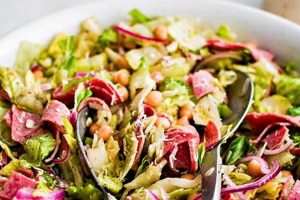A guide for preparing a dish where lettuce is softened, yet retains some texture, through the application of heat, usually from a warm dressing or quick sauting. This technique transforms the lettuce, mellowing its flavor and creating a tender, more palatable experience than a traditional raw salad. Examples include using spinach, romaine, or butter lettuce with bacon, warm vinaigrette, or a simple garlic and oil preparation.
This culinary approach offers several advantages. It provides a way to utilize lettuce that might be slightly past its prime for fresh salads, minimizing food waste. The wilting process also unlocks deeper flavors in the lettuce and allows for better absorption of dressings, leading to a richer, more satisfying dish. Historically, wilted lettuce salads served as a resourceful way to enjoy greens year-round, particularly during colder months when fresh produce was less readily available. They represent a bridge between raw salads and cooked greens, offering a unique textural and flavor profile.
This exploration will delve into various techniques for achieving the perfectly wilted lettuce, from classic bacon and vinegar combinations to more contemporary approaches using diverse ingredients and global influences. Specific examples and detailed instructions will empower readers to create their own delicious variations.
Tips for Wilted Lettuce Salads
Achieving optimal results with this cooking method requires attention to detail. These tips ensure a balanced and flavorful outcome.
Tip 1: Lettuce Selection: While various lettuces can be wilted, some varieties respond better to heat. Robust leaves like romaine, butter lettuce, or spinach hold their shape well, while more delicate greens like iceberg lettuce may become overly soft. Consider the desired texture when choosing lettuce.
Tip 2: Heat Control: Avoid overcooking the lettuce. The goal is to wilt, not to completely cook the leaves. Whether using a warm dressing or a pan, gentle heat is key to maintaining some texture and preventing a mushy outcome.
Tip 3: Dressing Timing: Adding the warm dressing at the right moment is crucial. Pouring it over the lettuce just before serving ensures the leaves wilt evenly without becoming soggy. For pan-wilted methods, the dressing can be incorporated during the final moments of cooking.
Tip 4: Flavor Balance: The warm dressing is the heart of the dish. Achieve a balance of acidity, sweetness, and savory notes. Classic combinations include bacon vinaigrette, warm garlic and oil, or a simple lemon and herb dressing.
Tip 5: Ingredient Combinations: Explore beyond traditional ingredients. Consider additions like toasted nuts, crumbled cheese, dried fruit, or caramelized onions to enhance flavor and texture.
Tip 6: Seasonality: Adjust ingredients based on seasonal availability. Spring salads might feature fresh herbs and asparagus, while fall versions could incorporate roasted root vegetables or apples.
Tip 7: Presentation: A visually appealing presentation enhances the dining experience. Arrange the wilted lettuce attractively on the plate, and garnish thoughtfully with complementary ingredients.
By following these guidelines, one can create wilted lettuce salads that are not only delicious but also showcase the versatility of this often-underappreciated cooking method. These dishes offer a delightful balance of textures and flavors, transforming simple greens into satisfying and memorable meals.
In conclusion, mastering the art of the wilted lettuce salad opens up a world of culinary possibilities.
1. Lettuce Selection
Lettuce selection significantly influences the outcome of a wilted lettuce salad. Different lettuce varieties possess unique characteristics that react differently to heat. Delicate lettuces, such as iceberg or red leaf, tend to wilt quickly and can become excessively soft or even mushy when exposed to warm dressings or cooking methods. Conversely, more robust lettuces, including romaine, butter lettuce, or Little Gem, maintain their structure and texture better when wilted, offering a more pleasing mouthfeel. Choosing the appropriate lettuce variety is, therefore, essential for achieving the desired texture and preventing a disappointing, watery salad.
Consider a salad featuring a warm bacon vinaigrette. Using delicate iceberg lettuce would likely result in a limp, unappealing dish due to the lettuce’s high water content and fragile structure. However, employing romaine lettuce would provide a more satisfying result. Romaine’s sturdy leaves would wilt gently while retaining enough structure to hold the dressing and other ingredients without becoming soggy. Similarly, using spinach in a wilted salad with a warm garlic dressing showcases the vegetable’s ability to hold its shape and provide a pleasant textural contrast to the soft, garlicky dressing.
Appropriate lettuce selection is crucial for optimizing the balance between tenderness and structure in a wilted lettuce salad. Understanding the characteristics of various lettuce varieties empowers one to create a dish that is both flavorful and visually appealing. Choosing robust lettuces ensures the salad retains a desirable texture and avoids an overly soft or watery consistency, ultimately elevating the overall dining experience. Careful selection contributes to a well-balanced and enjoyable culinary creation.
2. Wilt Method
The wilting method employed significantly influences the final character of a wilted lettuce salad. It dictates not only the texture of the lettuce but also how the flavors meld and develop. Selecting the appropriate technique is crucial for achieving the desired balance of tenderness and structure while enhancing the overall taste experience. Understanding the nuances of various wilting methods allows for greater control over the final product.
- Warm Dressing:
This classic method involves preparing a warm vinaigrette or dressing and pouring it over the lettuce just before serving. The gentle heat from the dressing wilts the leaves without the need for direct cooking. Examples include a warm bacon vinaigrette, a simple lemon-herb dressing, or a balsamic reduction. This approach preserves the fresh, vibrant color of the lettuce while imparting a delicate, nuanced flavor profile. The degree of wilting depends on the temperature of the dressing and the type of lettuce used. This technique is particularly well-suited for more delicate greens.
- Pan-Wilting:
This method involves quickly sauting the lettuce in a pan with a small amount of fat, such as butter or oil. The direct heat wilts the lettuce rapidly, creating a slightly more cooked flavor profile. This technique is ideal for sturdier lettuces like romaine or escarole. Pan-wilting offers greater control over the wilting process, allowing for a wider range of textures, from lightly wilted to more caramelized. It can also create a deeper, more complex flavor profile, especially when combined with aromatics like garlic or shallots.
- Steaming:
Steaming offers a gentler approach to wilting lettuce, preserving its vibrant color and delicate flavor. Briefly steaming the lettuce until just wilted creates a tender texture while minimizing nutrient loss. This method is particularly suitable for delicate greens like spinach or baby lettuces. Steaming requires less added fat compared to pan-wilting and avoids the potential for charring or overcooking.
- Broiling:
This technique involves briefly exposing the lettuce to high heat from a broiler. While less common, broiling can impart a subtle smoky flavor and slightly crisp the edges of the leaves, adding a unique textural dimension to the salad. This method works best with sturdier lettuces that can withstand intense heat without becoming overly soft or burnt. Careful attention to timing is crucial to prevent overcooking.
The choice of wilting method profoundly impacts the final dish, influencing the texture, flavor, and overall presentation. Each technique offers distinct advantages and caters to different lettuce varieties and desired outcomes. By understanding the nuances of each method, one can tailor the approach to create a wilted lettuce salad that perfectly complements the chosen ingredients and achieves the desired culinary result.
3. Dressing Choice
Dressing choice represents a pivotal element within wilted lettuce salad recipes. The dressing not only provides flavor but also contributes significantly to the wilting process itself, particularly when using the warm dressing method. Its interaction with the lettuce dictates the final texture and overall taste profile. A well-chosen dressing elevates the dish beyond simple greens, creating a complex and satisfying culinary experience. A mismatch, however, can lead to an unbalanced or underwhelming result. Therefore, careful consideration of dressing components and their interplay with the chosen lettuce variety is essential.
Consider a warm bacon vinaigrette. The rendered bacon fat contributes a savory richness, while the vinegar provides acidity that cuts through the fat and complements the smoky notes. The warmth of the dressing gently wilts the lettuce, allowing it to absorb the flavors more readily. In contrast, a lighter, citrus-based vinaigrette would offer a brighter, more refreshing counterpoint to the lettuce, delivering a different textural and flavor experience. A creamy dressing, like a warm blue cheese dressing, would provide a richer, more decadent profile. Understanding these nuances allows for strategic dressing selection based on the desired outcome. For instance, a delicate lettuce like butter lettuce might pair well with a light vinaigrette, while a sturdier romaine might benefit from a more robust, creamy dressing.
Successful wilted lettuce salads rely heavily on appropriate dressing selection. The dressing’s temperature, acidity, and flavor profile directly impact the lettuce’s texture and how its inherent flavors integrate with other ingredients. Practical application of this understanding ensures a harmonious balance and a more enjoyable sensory experience. Failure to consider the interplay between dressing and lettuce can lead to a dish that falls short of its potential, highlighting the critical role dressing choice plays in the overall success of a wilted lettuce salad.
4. Flavor Balance
Flavor balance constitutes a critical aspect of successful wilted lettuce salad recipes. The interplay of tastessweet, sour, salty, bitter, and umamidetermines the overall palatability and complexity of the dish. A harmonious balance elevates the inherent flavors of the lettuce and other ingredients, creating a synergistic and satisfying experience. An imbalance, conversely, can result in a one-dimensional or discordant taste profile, diminishing the enjoyment of the salad.
Consider a wilted spinach salad with warm bacon vinaigrette. The saltiness of the bacon provides a savory foundation, balanced by the acidity of the vinegar in the vinaigrette. A touch of sweetness, perhaps from a drizzle of maple syrup or a sprinkle of brown sugar, rounds out the flavor profile, preventing the salt and acid from dominating. The spinach itself contributes a subtle bitterness, further enhancing the complexity of the dish. Without this careful balance, the salad might be overly salty, excessively sour, or simply bland. Another example could involve a wilted romaine salad with a warm blue cheese dressing. The pungent, salty blue cheese requires a counterpoint, perhaps from the sweetness of dried cranberries or the tartness of chopped apples. The romaine’s slightly bitter notes add another layer of complexity, creating a well-rounded flavor experience.
Achieving flavor balance requires an understanding of how different tastes interact and how to adjust ingredients to create a harmonious profile. This understanding allows for informed decisions regarding dressing choice, ingredient pairings, and seasoning. Practical application of these principles elevates wilted lettuce salads from simple preparations to well-crafted dishes that showcase the interplay of flavors. It transforms a potentially mundane meal into a nuanced and satisfying culinary experience, highlighting the importance of flavor balance as a cornerstone of successful wilted lettuce salad recipes.
5. Ingredient Pairings
Ingredient pairings significantly influence the complexity and balance of wilted lettuce salad recipes. Thoughtful combinations elevate the dish beyond simple greens and a warm dressing, creating a nuanced interplay of flavors and textures. Understanding the relationships between ingredientshow they complement, contrast, or enhance one anotheris crucial for achieving a successful outcome. This knowledge enables informed decisions that result in a harmonious and satisfying culinary experience. Conversely, poorly chosen pairings can lead to a muddled or unbalanced flavor profile, diminishing the overall enjoyment of the salad.
Consider the classic pairing of wilted spinach with bacon and warm vinaigrette. The smoky, salty bacon complements the spinach’s earthy notes, while the warm vinaigrette wilts the leaves and adds a touch of acidity to cut through the richness of the bacon. The crisp bacon provides a textural contrast to the tender spinach, creating a more dynamic sensory experience. Another example is a wilted romaine salad with warm blue cheese dressing, candied walnuts, and dried cranberries. The pungent blue cheese pairs well with the sweet and tart cranberries, while the crunchy walnuts offer a textural counterpoint to the soft lettuce and creamy dressing. The slight bitterness of the romaine adds another layer of complexity, balancing the richness of the other ingredients. These pairings create a multi-dimensional flavor profile that would be lacking if the ingredients were considered in isolation.
Effective ingredient pairings in wilted lettuce salads rely on a combination of complementary and contrasting elements. Understanding these principles allows for strategic ingredient selection, maximizing flavor and textural complexity. This informed approach transforms simple ingredients into a cohesive and satisfying dish. The practical application of this knowledge ensures a more enjoyable dining experience, demonstrating the vital role ingredient pairings play in successful wilted lettuce salad recipes.
6. Temperature Control
Temperature control represents a critical factor in achieving optimal results with wilted lettuce salads. The degree of heat applied, whether from a warm dressing or a cooking process, directly influences the lettuce’s final texture and flavor. Precise temperature management ensures the lettuce wilts gently, achieving the desired tenderness without becoming mushy or overcooked. Conversely, inadequate temperature control can result in undesirable outcomes, ranging from undercooked, tough lettuce to an unappetizing, slimy mess.
Consider the warm dressing method. A dressing that is too hot can cause the lettuce to wilt too rapidly, resulting in uneven texture and potentially leaching out excessive moisture. A dressing that is not warm enough may fail to adequately wilt the lettuce, leaving it tough and raw. Similar considerations apply to pan-wilting or steaming. Excessive heat can scorch delicate leaves, imparting a bitter flavor, while insufficient heat fails to achieve the desired tenderness. For instance, when preparing a wilted spinach salad with warm bacon vinaigrette, the vinaigrette should be warm enough to wilt the spinach but not so hot that it cooks the leaves. Similarly, when pan-wilting romaine lettuce, the pan’s temperature must be high enough to wilt the lettuce quickly but not so high that it burns.
Mastery of temperature control in wilted lettuce salad preparation ensures a desirable texture and optimizes flavor development. Careful attention to temperature throughout the process, whether using a warm dressing or a cooking method, is essential. This precision prevents overcooking or undercooking, resulting in a balanced and enjoyable culinary outcome. Understanding the impact of temperature on different lettuce varieties and adjusting techniques accordingly allows one to create wilted lettuce salads that are both flavorful and visually appealing. Neglecting this crucial element can compromise the dish, underscoring the significance of temperature control in achieving culinary excellence.
7. Presentation
Presentation plays a crucial role in the overall enjoyment of a wilted lettuce salad. While flavor and texture are paramount, visual appeal enhances the dining experience, transforming a simple dish into something more enticing. Consideration of color, arrangement, and garnish elevates the perceived value and palatability of the salad, influencing the diner’s perception even before the first bite.
- Color Contrast:
A visually appealing salad utilizes contrasting colors to create interest. The green of the lettuce can be offset by vibrant ingredients such as red tomatoes, orange carrots, or purple onions. Consider a wilted spinach salad with a warm bacon vinaigrette. The dark green of the spinach contrasts beautifully with the reddish-brown bacon and the bright yellow of a poached egg. This contrast stimulates visual interest and appetite.
- Height and Texture:
Creating visual depth through varying heights and textures enhances the presentation. A flat, one-dimensional salad lacks visual appeal. Incorporating elements like toasted nuts, crumbled cheese, or crispy croutons adds textural contrast and visual interest. A wilted romaine salad can be made more visually appealing by adding toasted pine nuts, crumbled goat cheese, and segments of orange. The varying heights and textures create a more dynamic presentation.
- Garnish Selection:
Garnishes provide the finishing touch, adding a pop of color, flavor, and texture. A simple sprig of fresh herbs, a sprinkle of chopped chives, or a drizzle of balsamic glaze can elevate the presentation significantly. For example, a wilted butter lettuce salad with a warm lemon-herb dressing can be garnished with fresh parsley and a lemon wedge. The garnish complements the flavors of the salad while enhancing its visual appeal. Care should be taken to ensure the garnish complements the flavors of the dish and does not overpower the presentation.
- Plate Choice:
The choice of serving plate or bowl influences the overall presentation. A white plate provides a neutral backdrop that allows the colors of the salad to stand out. A shallow bowl can be used for salads with a more substantial dressing, while a larger platter is suitable for serving a wilted lettuce salad family-style. The size and shape of the plate should complement the salad and the overall dining setting. Using appropriately sized servingware enhances the visual appeal and avoids a cluttered or underwhelming presentation.
These elements of presentation, when thoughtfully considered, transform a wilted lettuce salad from a simple dish into a visually appealing culinary creation. Attention to color contrast, textural variation, appropriate garnishes, and plate choice enhances the dining experience, making the salad more inviting and enjoyable. These details demonstrate that presentation is not merely an afterthought but an integral component of a successful recipe, elevating the perceived quality and enjoyment of the dish.
Frequently Asked Questions
This section addresses common inquiries regarding wilted lettuce salad preparation, offering practical guidance for achieving optimal results.
Question 1: Can any type of lettuce be used for wilted salads?
While many lettuce varieties can be wilted, some are better suited to the process than others. Heartier lettuces like romaine, butter lettuce, and escarole hold their shape well when exposed to heat, while more delicate varieties like iceberg or red leaf lettuce tend to become overly soft and mushy. Choosing the right lettuce is crucial for achieving the desired texture.
Question 2: What is the best method for wilting lettuce?
The optimal wilting method depends on the desired outcome and the type of lettuce used. Warm dressings gently wilt the leaves, preserving their fresh flavor and color. Pan-wilting offers greater control over texture, allowing for a slightly more cooked flavor profile. Steaming preserves color and nutrients but may require more attention to prevent over-wilting. The best method depends on individual preferences and the specific recipe.
Question 3: How can one prevent wilted lettuce from becoming soggy?
Sogginess often results from over-wilting or using excessive dressing. Careful temperature control, whether using a warm dressing or a pan, is essential. Ensure the dressing is warm, not hot, and avoid overexposure to heat. Dress the salad just before serving to prevent the lettuce from sitting in the dressing and becoming saturated.
Question 4: What are some suitable dressing options for wilted lettuce salads?
Warm vinaigrettes, bacon dressings, and creamy dressings like blue cheese or ranch are popular choices. The key is to balance flavors and consider the lettuce variety. Delicate lettuces pair well with lighter vinaigrettes, while sturdier greens can handle richer, more robust dressings. The dressing should complement the other ingredients and enhance the overall flavor profile.
Question 5: Can wilted lettuce salads be served warm or cold?
Wilted lettuce salads are typically served warm, as the heat is integral to the wilting process and flavor development. However, some variations can be served at room temperature or slightly chilled, depending on the specific recipe and personal preference. Serving temperature can influence the perceived flavors and textures.
Question 6: How long can wilted lettuce salad be stored?
Ideally, wilted lettuce salads are best consumed immediately after preparation to enjoy optimal texture and flavor. Storing wilted lettuce can lead to further softening and potential sogginess. If storage is necessary, store the lettuce and dressing separately and combine just before serving. Refrigerate any leftovers promptly and consume within one to two days.
Understanding these fundamental aspects of wilted lettuce salad preparation empowers one to create delicious and visually appealing dishes. Careful consideration of lettuce selection, wilting method, dressing choice, and temperature control ensures optimal results.
The following sections will explore specific wilted lettuce salad recipes, offering step-by-step instructions and variations for diverse tastes.
Conclusion
Exploration of recipes for wilted lettuce salad reveals a culinary approach offering versatility and depth. Careful selection of lettuce variety, appropriate wilting methods, balanced dressings, and complementary ingredient pairings contribute to successful outcomes. Temperature control is paramount, ensuring ideal texture and preventing sogginess. Thoughtful presentation elevates the dining experience, transforming a simple preparation into a visually appealing dish.
This exploration underscores the potential of wilted lettuce salads to transcend their humble origins. They represent an opportunity to minimize food waste by utilizing slightly less-than-perfect lettuce, while simultaneously creating dishes rich in flavor and texture. Further experimentation with diverse ingredients and global influences promises to expand the culinary landscape of wilted lettuce salads, offering a continuing source of culinary inspiration and enjoyment.






